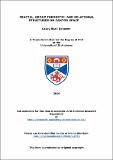Files in this item
Fractal, group theoretic, and relational structures on Cantor space
Item metadata
| dc.contributor.advisor | Falconer, K. J. | |
| dc.contributor.advisor | Bleak, Collin Patrick | |
| dc.contributor.author | Donoven, Casey Ryall | |
| dc.coverage.spatial | vi, 121 leaves | en_US |
| dc.date.accessioned | 2017-08-03T15:38:28Z | |
| dc.date.available | 2017-08-03T15:38:28Z | |
| dc.date.issued | 2016 | |
| dc.identifier.uri | https://hdl.handle.net/10023/11370 | |
| dc.description.abstract | Cantor space, the set of infinite words over a finite alphabet, is a type of metric space with a `self-similar' structure. This thesis explores three areas concerning Cantor space with regard to fractal geometry, group theory, and topology. We find first results on the dimension of intersections of fractal sets within the Cantor space. More specifically, we examine the intersection of a subset E of the n-ary Cantor space, C[sub]n with the image of another subset Funder a random isometry. We obtain almost sure upper bounds for the Hausdorff and upper box-counting dimensions of the intersection, and a lower bound for the essential supremum of the Hausdorff dimension. We then consider a class of groups, denoted by V[sub]n(G), of homeomorphisms of the Cantor space built from transducers. These groups can be seen as homeomorphisms that respect the self-similar and symmetric structure of C[sub]n, and are supergroups of the Higman-Thompson groups V[sub]n. We explore their isomorphism classes with our primary result being that V[sub]n(G) is isomorphic to (and conjugate to) V[sub]n if and only if G is a semiregular subgroup of the symmetric group on n points. Lastly, we explore invariant relations on Cantor space, which have quotients homeomorphic to fractals in many different classes. We generalize a method of describing these quotients by invariant relations as an inverse limit, before characterizing a specific class of fractals known as Sierpiński relatives as invariant factors. We then compare relations arising through edge replacement systems to invariant relations, detailing the conditions under which they are the same. | en_US |
| dc.language.iso | en | en_US |
| dc.publisher | University of St Andrews | en |
| dc.subject.lcc | QA174.2D7 | |
| dc.subject.lcsh | Cantor sets | en |
| dc.subject.lcsh | Fractals | en |
| dc.subject.lcsh | Group theory | en |
| dc.subject.lcsh | Topological spaces | en |
| dc.title | Fractal, group theoretic, and relational structures on Cantor space | en_US |
| dc.type | Thesis | en_US |
| dc.type.qualificationlevel | Doctoral | en_US |
| dc.type.qualificationname | PhD Doctor of Philosophy | en_US |
| dc.publisher.institution | The University of St Andrews | en_US |
This item appears in the following Collection(s)
Items in the St Andrews Research Repository are protected by copyright, with all rights reserved, unless otherwise indicated.

